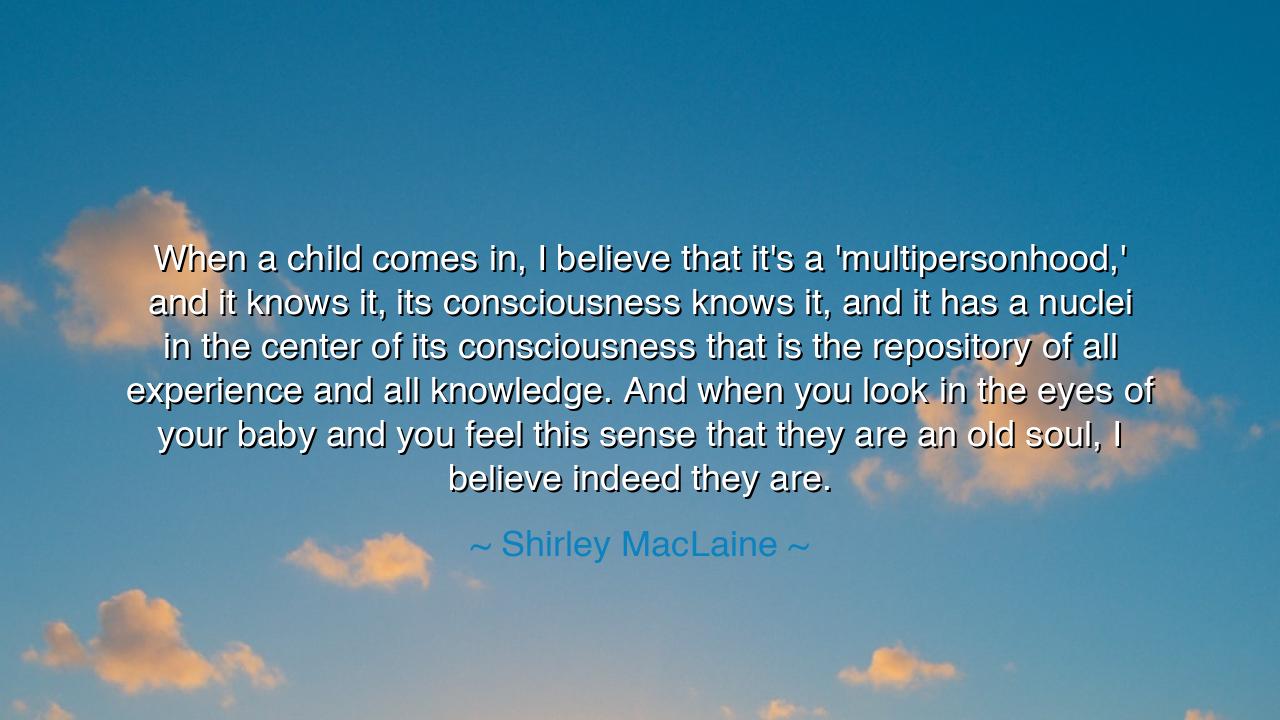
When a child comes in, I believe that it's a 'multipersonhood,'
When a child comes in, I believe that it's a 'multipersonhood,' and it knows it, its consciousness knows it, and it has a nuclei in the center of its consciousness that is the repository of all experience and all knowledge. And when you look in the eyes of your baby and you feel this sense that they are an old soul, I believe indeed they are.






The words of Shirley MacLaine—“When a child comes in, I believe that it's a 'multipersonhood,' and it knows it, its consciousness knows it, and it has a nuclei in the center of its consciousness that is the repository of all experience and all knowledge. And when you look in the eyes of your baby and you feel this sense that they are an old soul, I believe indeed they are”—speak with a mystical tenderness that reaches beyond time. In them echoes the ancient belief that the human spirit does not begin at birth, nor end at death, but moves through the ages, gathering wisdom as a traveler gathers stars. Her words are a meditation on the immortality of consciousness, the idea that within each of us resides the essence of all who have been and all who will be. To see a child not as a blank page, but as a returning soul, is to view life through the lens of eternity.
MacLaine, long known for her spiritual philosophy and belief in reincarnation, draws here upon traditions that span civilizations. The notion that a newborn carries within it a repository of experience is as old as the Vedas of India, where the soul—Atman—is described as eternal and all-knowing, reborn again and again to continue its journey toward enlightenment. The ancient Greeks, too, spoke of the soul’s immortality; Plato, in his dialogue Phaedrus, wrote that all learning is recollection—that the soul, having lived many lives, remembers truth rather than discovers it. MacLaine’s “multipersonhood” is thus a modern articulation of this timeless wisdom: that a child is not one being, but many; not a beginning, but a continuation of a story written in light before birth.
When she speaks of the nucleus in the center of consciousness, she refers to what sages have long called the divine spark, the seed of knowledge carried through lifetimes. This nucleus, this sacred core, is what mystics across cultures have sought to awaken—the point where the finite self touches the infinite. It is the same truth found in the teachings of the Buddha, who said that within each person lies the potential of all awareness, and in the words of Jesus, who declared that “the Kingdom of God is within you.” To recognize this in a child is to see divinity itself made visible, to look into the eyes of innocence and perceive eternity gazing back.
There is a story told of the Dalai Lama, who as a young boy was brought before the elders to be tested for signs of his past life. Before him lay a collection of objects—some belonging to his predecessor, others not. Without hesitation, the child chose those that were truly his. The elders wept, for they saw in his hands the living proof of the soul’s continuity. In the same way, MacLaine’s words remind us that when a parent holds their newborn and feels the uncanny sense that the child is an old soul, they may indeed be glimpsing a consciousness that has walked many paths before returning to their arms. Such recognition binds the generations not merely by blood, but by the shared river of spirit flowing through them.
The beauty of her insight lies not only in its mysticism, but in its invitation to reverence. If we see each child as a multipersonhood, a bearer of ancient wisdom, then parenting becomes not an act of shaping, but of listening. We become students as much as guides, learning anew what our children, in their purity, still remember. In a world that often sees infancy as ignorance and youth as emptiness waiting to be filled, MacLaine’s philosophy restores sacred dignity to every soul at every stage. It teaches that within even the smallest child dwells the wisdom of the cosmos, waiting patiently to be recognized.
The lesson her words offer is profound: treat every being—child or elder—as a vessel of memory and light. When we gaze into another’s eyes and feel the mysterious familiarity of their presence, we are not imagining it; we are remembering what the soul already knows. Each encounter, each bond, may be the continuation of a story begun long before. To live with this awareness is to walk gently upon the earth, honoring the divine depth of every life.
So let her words be carried forward as both comfort and calling. When you look upon a child, do not see a fragile beginning—see a timeless traveler wrapped in new flesh. When you look upon yourself, remember that you too are ancient, carrying within you the whole history of your soul. And when you look upon others, let compassion rise from the recognition that we are all, in truth, old souls learning anew—each of us a multipersonhood, bound together in the infinite tapestry of existence.






AAdministratorAdministrator
Welcome, honored guests. Please leave a comment, we will respond soon